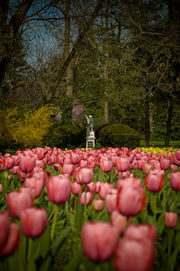Lexington, Kentucky
| City of Lexington | |
|---|---|
| — City — | |
|
|
|
| Nickname(s): "Horse Capital of the World", "Athens of the West" | |
 |
|
| Coordinates: | |
| Country | United States |
| State | Kentucky |
| Counties | Fayette |
| Government | |
| - Mayor | Jim Newberry (D) |
| Area | |
| - City | 285.5 sq mi (739.5 km2) |
| - Land | 284.5 sq mi (736.9 km2) |
| - Water | 1.0 sq mi (2.6 km2) |
| - Urban | 69.5 sq mi (180.1 km2) |
| Elevation | 978 ft (298 m) |
| Population (2009) | |
| - City | 296,545 |
| - Density | 953/sq mi (364.5/km2) |
| - Urban | 260,994 |
| - Metro | 453,424 |
| Time zone | EST (UTC-5) |
| - Summer (DST) | EDT (UTC-4) |
| ZIP Code | 40502–40517, 40522–40524, 40526, 40533, 40536, 40544, 40546, 40550, 40555, 40574–40583, 40588, 40591, 40598 |
| Website | http://www.lexingtonky.gov/ |
Lexington (officially Lexington-Fayette Urban County) is the second-largest city in Kentucky and the 65th largest in the United States. Known as the "Thoroughbred City" and the "Horse Capital of the World", it is located in the heart of Kentucky's Bluegrass region. In 2009 the city's population was estimated at 296,545[1] anchoring a metropolitan area of 470,849 people[2] and a Combined Statistical Area of 688,707 people.[3]
Lexington ranks 10th among US cities in college education rate, with 39.5% of residents having at least a Bachelor's Degree.[4] It is home to the headquarters of Lexmark International, the Kentucky Horse Park, Keeneland race course, Red Mile race course, Transylvania University, the University of Kentucky and Bluegrass Community & Technical College.
Lexington has been selected to be the site of the 2010 FEI World Equestrian Games.[5]
Contents |
History
- See also: History of Kentucky

Lexington was founded in June 1775 in what was then Virginia (17 years before Kentucky became a state in 1792). A party of frontiersmen, led by William McConnell, camped on the Middle Fork of Elkhorn Creek (today called Town Branch and rerouted under Vine Street) at the location known today as McConnell Springs. Upon hearing of the colonists' victory in the Battles of Lexington and Concord, on April 19, 1775, they named their campsite Lexington after Lexington, Massachusetts. Due to the danger of Indian attacks, permanent settlement was delayed for four years. In 1779, Colonel Robert Patterson and 25 companions came from Fort Harrod and erected a blockhouse. Cabins and a stockade were soon built, making the fort, known as Bryan Station, a place of importance. Colonists defended it against a British and American Indian attack in 1782, during the last part of the American Revolution.
The town of Lexington was established on May 6, 1782, by an act of the Virginia General Assembly. The First African Baptist Church was founded c. 1790 by Peter Durrett[6], a Baptist preacher and slave held by Rev. Joseph Craig. Durrett had accompanied Craig and helped guide The Traveling Church on their migration from Virginia to Kentucky in 1781. After 1784 he and his wife hired out to John Campbell of Lexington, who let them build a cabin on his property at Maxwell Spring. This is where Peter founded the first African Baptist congregation.[7] It is the oldest black Baptist congregation in Kentucky and the third oldest in the United States.[8]
By 1820, Lexington was one of the largest and wealthiest towns west of the Allegheny Mountains. So cultured was its lifestyle that the city gained the nickname "Athens of the West". One early prominent citizen, John Wesley Hunt, became the first millionaire west of the Alleghenies. The growing town was devastated by a cholera epidemic in 1833: 500 of 7,000 residents died within two months, including nearly one-third of the congregation of Christ Church Episcopal.[9] Additional outbreaks occurred in 1848-49 and the early 1850s. Cholera was spread by people using contaminated water supplies. Often the wealthier people would flee town for outlying areas to try to avoid the spread of disease.
Planters held slaves for use as artisans and laborers, field hands and domestic servants. In the city, slaves worked primarily as domestic servants and artisans, although they also worked with merchants, shippers and a wide variety of trades. In 1850, 1/5 of the state's population were slaves, and Lexington had the highest concentration of slaves in the state.

Many of 19th-century America's most important people spent part of their lives in the city, including both United States president Abraham Lincoln and Confederate President Jefferson Davis (who attended Transylvania University in 1823 and 1824), Civil War General John Hunt Morgan, US Senator and vice president John C. Breckinridge, and US Senator and presidential candidate Henry Clay, who had a plantation nearby. Lincoln's wife, Mary Todd Lincoln, was born and raised in Lexington; the couple visited the city several times after their marriage in 1842.
In 1935 Lexington founded one of the first drug rehabilitation clinics, known as the "Addiction Research Center".[10] The first alcohol and drug rehabilitation hospital in the United States was also known as "Narco" of Lexington, as well as the "Addiction Research Center". This was later converted into a federal prison.
Geography
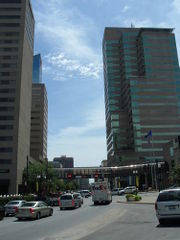
Lexington, which includes all Fayette County, consists of 285.5 square miles (739.4 km2), mostly gently rolling plateau, in the center of the inner Bluegrass Region. The area is noted for its fertile soil, excellent pastureland, and horse and stock farms. Poa pratensis (bluegrass) thrives on the limestone beneath the soil's surface, playing a major role in the area's scenic beauty and in the development of champion horses. Numerous small creeks rise and flow into the Kentucky River.
The Lexington-Fayette Metro area is home to six counties: Clark, Jessamine, Bourbon, Woodford, Scott, and Madison. This is the second largest metro area in the Ohio Valley and in Kentucky. According to the United States Census Bureau, the city has a total area of 285.5 square miles (739 km2). 284.5 square miles (737 km2) of it is land and 1.0 square mile (2.6 km2) of it (0.35%) is water.[11]
Climate
Lexington is in the humid subtropical climate,[12] although nearing the humid continental climate. Summers are hot and humid, and winters are cool with mild periods.
The average temperature in Lexington is 54.9 °F (12.7 °C). Annual precipitation is 45.68 inches (1,160 mm). Lexington and the Bluegrass have four distinct seasons that include cool plateau breezes, moderate nights in the summer, and no prolonged periods of heat, cold, rain, wind, or snow.
Lexington is recognized as a high allergy area by the Asthma and Allergy Foundation of America.[13] The results for the spring of 2008 rank Lexington at first.
| Climate data for Lexington, Kentucky | |||||||||||||
|---|---|---|---|---|---|---|---|---|---|---|---|---|---|
| Month | Jan | Feb | Mar | Apr | May | Jun | Jul | Aug | Sep | Oct | Nov | Dec | Year |
| Source: http://www.climate-zone.com/climate/united-states/kentucky/lexington/ | |||||||||||||
Cityscape
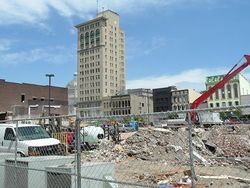
Lexington features a diverse cityscape. From its vibrant downtown, which supports infill and historic preservation projects, to its famed horse farms, the city prides itself in featuring an urban growth boundary that includes greenbelts and strict zoning definitions. This has been done not only to protect the Bluegrass landscape from further development but to protect thoroughbred horse farms, the trademark industry of the region.
The city is home to several notable high rises. As of 2009, the Lexington Financial Center is the tallest building, followed by Kincaid Towers, and the World Trade Center complex. It is the location of many other notable structures and to many new urban developments in two major districts. In recent years numerous condominium projects and shopping centers have opened in the old Tobacco Warehouse District just south of Downtown. Due to uncertain financial backing, after demolishing the existing buildings, construction has never started on what was to be the state's second tallest building, CentrePointe, which would be 550 feet (170 m) tall if built, and the site is now planted with grass.[14]
Forbes has named Lexington as one of the world's seventeen cleanest cities.[15]

Planning
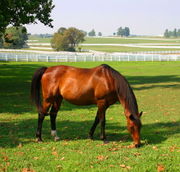
Lexington faces a unique challenge among American cities in that it must manage a rapidly growing population while maintaining the character of the surrounding horse farms that give the region its identity. To do so Lexington enacted the nation's first Urban Growth Boundary in 1958, where new development could only occur in the Urban Service Area. It set a strict minimum area requirement, currently 40 acres (160,000 m2), to maintain open space in the Rural Service Area.[16] A historic District Zoning Overlay was adopted as well to protect the historic character of the surrounding neighborhoods.
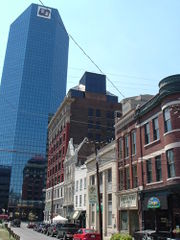
Two years later, a comprehensive Design Plan for the downtown was completed,[17] which called for the removal of the Chesapeake and Ohio Railway lines on what is today's Vine Street. In 1967, the Urban Service Area was decreased in area; various zoning regulations were also amended from the original 1958 issue. Several years later, in 1973, the first Lexington Comprehensive Plan was completed.
In 1980, the Comprehensive Plan was updated and the Urban Service Area was modified to include Urban Activity Centers and Rural Activity Centers.[17] The Urban Activity Centers were commercial and light-industrial districts in urbanized areas, while Rural Activity Centers were retail trade and light-industrial centers clustered around the Interstate 64/Interstate 75 interchanges. In 1996, the Urban Service Area was expanded when 5,300 acres (21 km2) of the Rural Service Area was acquired through the Expansion Area Master Plan.[16] This was not without controversy; the first major update to the Comprehensive Plan in over a decade was accompanied by arguments about the future of Lexington and the thoroughbred farms.[17] The Expansion Area Master Plan included impact fees, assessment districts, neighborhood design concepts, design overlays, mandatory greenways, major roadway improvements, stormwater management and open space mitigation for the first time; it also included a draft of the Rural Land Management Plan, which included large-lot zoning and traffic impact controls. A pre-zoning of the entire expansion area was refuted in the Plan. A 50-acre (200,000 m2) minimum proposal was also defeated, although discussion of the proposal led to a deluge of 10-acre (40,000 m2) subdivisions in the Rural Service Areas.[17]
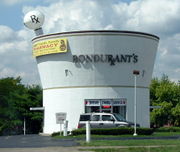
Three years after the expansion was initiated, the Rural Service Area Land Management Plan was adopted, which increased the minimum lot size in the agricultural rural zones to 40-acre (160,000 m2) minimums.[16] In 1998, a moratorium was issued on rural lot creations to curb the development of new rural 10-acre (40,000 m2) subdivisions, which were incompatible with the existing agricultural uses. Two years later, the Purchase of Development Rights plan was adopted, which granted the city power to purchase the development rights of existing farms; in 2001, $40 million was allocated to the plan from a $25 million local, $15 million state grant.[17] An Infill and Redevelopment study was also initiated during that time, along with design guidelines for the areas surrounding the new Fayette County courthouses.
Government and politics
Federally, Lexington is part of Kentucky's 6th congressional district, represented by Democrat Ben Chandler, elected in 2004.
The state's senior member of the United States Senate is the Republican Floor Leader, Mitch McConnell, elected in 1984. The state's junior member of the United States Senate is Republican Jim Bunning, elected in 1998. The Governor of Kentucky is Democrat Steve Beshear, elected in 2007.
In 1974, the governments of the city of Lexington and Fayette County, Kentucky combined to create the current Lexington-Fayette Urban County Government, often abbreviated LFUCG. Lexington has an elected mayor and city council-style of government.
Mayor
On November 7, 2006, Jim Newberry was elected Mayor of Lexington.[18] In January 2007, he succeeded Teresa Isaac, the city's mayor since 2002. During Isaac's tenure as Mayor, Lexington was the largest American city with an Arab-American mayor.[19]
Urban County Council
The Urban County Council is a fifteen-member legislative group. Twelve of the members represent specific districts and serve two-year terms; three are elected city-wide as at-large council members and serve four-year terms. The at-large member receiving the highest number of votes in the general election automatically becomes the Vice Mayor who, in the absence of the Mayor, is the presiding officer of the Council. The current council members are:
- Jim Gray: Vice Mayor
- Linda Gorton: At-Large
- Chuck Ellinger II: At-Large
- 1st District: Andrea James
- 2nd District: Tom Blues
- 3rd District: Diane Lawless
- 4th District: Julian Beard
- 5th District: Cheryl Feigel
- 6th District: Kevin Stinnett
- 7th District: K. C. Crosbie
- 8th District: George Myers
- 9th District: Jay McChord
- 10th District: Doug Martin
- 11th District: Peggy Henson
- 12th District: Ed Lane
The Urban County Council Clerk is Susan Lamb.
Law enforcement
Primary law enforcement duties within Lexington are the responsibility of the Lexington-Fayette Urban County Government Division of Police. The Division of Police resulted from the merger of the Lexington Police Department with the Fayette County Patrol in 1974. The Fayette County Sheriff's Office is responsible for court service, including court security, prisoner transport, process and warrant service, and property tax collection. The University of Kentucky Police Department, the Transylvania University Department of Public Safety, Blue Grass Airport Public Safety, Fayette County Schools Department of Law Enforcement, the Veterans Affairs Police Department and the Kentucky Horse Park Police also have jurisdiction within their geographic areas in Lexington-Fayette County. In addition, the Lexington-Fayette Animal Care & Control exercises law enforcement over animal control issues and the Kentucky State Police, Kentucky Vehicle Enforcement and Kentucky Department of Fish and Wildlife Resources can be seen performing their respective law enforcement duties within the county.
Demographics
| Historical populations | |||
|---|---|---|---|
| Census | Pop. | %± | |
| 1790 | 18,410 |
|
|
| 1800 | 14,028 | −23.8% | |
| 1810 | 21,370 | 52.3% | |
| 1820 | 23,250 | 8.8% | |
| 1830 | 25,098 | 7.9% | |
| 1840 | 22,194 | −11.6% | |
| 1850 | 22,735 | 2.4% | |
| 1860 | 22,599 | −0.6% | |
| 1870 | 26,656 | 18.0% | |
| 1880 | 29,023 | 8.9% | |
| 1890 | 35,698 | 23.0% | |
| 1900 | 42,071 | 17.9% | |
| 1910 | 47,715 | 13.4% | |
| 1920 | 54,664 | 14.6% | |
| 1930 | 68,543 | 25.4% | |
| 1940 | 78,899 | 15.1% | |
| 1950 | 100,746 | 27.7% | |
| 1960 | 131,906 | 30.9% | |
| 1970 | 174,323 | 32.2% | |
| 1980 | 204,165 | 17.1% | |
| 1990 | 225,366 | 10.4% | |
| 2000 | 260,512 | 15.6% | |
| Est. 2009 | 296,545 | 13.8% | |
| http://ukcc.uky.edu/~census/21067.txt | |||
The Lexington-Fayette Metropolitan Statistical Area (MSA) includes Bourbon, Clark, Fayette, Jessamine, Scott, and Woodford counties. The MSA population in 2006 was estimated at 436,684.[2] The Lexington-Fayette-Frankfort-Richmond, KY Combined Statistical Area had an estimated population of 645,006 in 2006. This includes the metro area and an additional seven counties.[3]
As of the census[20] of 2000, there were 260,512 people, 108,288 households, and 62,915 families residing in the city. The population density was 915.6 people per square mile (353.5/km²). There were 116,167 housing units at an average density of 408.3/mi² (157.6/km²). The racial makeup of the city was 81.04% White, 13.48% African American, 0.19% Native American, 2.46% Asian, 0.03% Pacific Islander, 1.21% from other races, and 1.58% from two or more races. Hispanics or Latinos of any race were 3.29% of the population.
There were 108,288 households out of which 27.3% had children under the age of 18 living with them, 43.5% were married couples living together, 11.5% had a female householder with no husband present, and 41.9% were non-families. 31.7% of all households were made up of individuals and 7.5% had someone living alone who was 65 years of age or older. The average household size was 2.29 and the average family size was 2.90.
The age distribution was 21.3% under the age of 18, 14.6% from 18 to 24, 33.2% from 25 to 44, 20.9% from 45 to 64, and 10.0% who were 65 years of age or older. The median age was 33 years. For every 100 females there were 96.5 males. For every 100 females age 18 and over, there were 94.3 males.
The median income for a household in the city was $39,813, and the median income for a family was $53,264. Males had a median income of $36,166 versus $26,964 for females. The per capita income for the city was $23,109. About 8.2% of families and 12.9% of the population were below the poverty line, including 14.3% of those under the age of 18 and 8.6% of those ages 65 and older.
Sources:
- 1790 to 1960 census:[21]
- 1970 census:[22]
- 1980 census:[23]
- 1990 census:[24]
- 2000 to 2005 census:[25]
- 2006 census:[1]

Economy
With its abundance of government and technology jobs, Lexington has one of the nation's most stable economies. Economists have referred to Lexington as having "a fortified economy, strong in manufacturing, technology and entrepreneurial support, benefiting from a diverse, balanced business base".[26] The Lexington Metro Area had a July 2008 unemployment rate of only 5.4%,[27] compared to national average of 6.1%. Lexington was named the 5th best city for "Businesses and Careers" in 2008 by Forbes Magazine,[28] and the 5th best city for Young Professionals in 2008 by Kiplinger.[29]
As such, the city is home to several large corporations. There are three Fortune 500 companies located within the city, Affiliated Computer Services, Lexmark International and Hewlett Packard, employing 1,200, 3,450, and 250 respectively.[30] United Parcel Service, Trane and Amazon.com, Inc. have a large presence in the city, and Toyota Motor Manufacturing Kentucky is within the Lexington CSA in adjoining Georgetown. The city is also host to a Jif peanut butter plant that produces more peanut butter than any other factory in the world,[31] and to the Forcht Group of Kentucky, a holding company that employs more than 2,100 people across Kentucky. Forcht Group operates several businesses in Lexington including First Corbin Bancorp, Kentucky National Insurance Company, My Favorite Things, BSC, a bank data services company, and First Lab, among others.
Another large employer, the University of Kentucky, employs 10,668,[30] however, it does not include the College of Agriculture’s Cooperative Extension Service which has a staff of over 900.[32] The University is the ninth largest economic company in the state of Kentucky, with an annual budget of $1.4 billion, and the College of Medicine within the University is the 21st largest company in the state.
Other sizable employers include the Lexington-Fayette County government and other hospital facilities. This includes the Fayette County Public Schools, employing 4,651, and the Lexington-Fayette Urban County Government, employing 3,936. Central Baptist Hospital, Saint Joseph Hospital, Saint Joseph East, and the Veterans Administration Hospital employ 6,206 total.[30]
Education
According to the United States Census, of Lexington's population over the age of twenty-five, 22.4% hold a bachelor's degree, 11.4% hold a master's degree, and 3.1% hold a professional degree. Just 2.6% hold a doctorate degree. Lexington was also ranked 10th in a list of America's most educated cities with a population of more than 250,000, ranked by percentage of bachelor's degrees among residents 25 and older, according to the United States Census Bureau.[33] A report released by Jack Miller, president of Central Connecticut State University, Lexington ranks 13th in the United States in terms of literacy rate.[34] The index was compiled through six indicators of literacy, including Internet sources, newspaper circulation, the number of bookstores, library resources, education and periodical resources.
The city is served by the Fayette County Public Schools. The system consists of 5 high schools, 11 middle schools, and 33 elementary schools, along with six private schools. There are also two traditional colleges, the University of Kentucky and the state's oldest, Transylvania University. Other institutions of higher learning include Bluegrass Community and Technical College, Sullivan University, Spencerian College, Strayer University, Commonwealth Baptist College, and a newly opened distance learning extension of Indiana Wesleyan University.
Culture
Annual cultural events and fairs
Lexington is home to many thriving arts organizations including a professional orchestra, two ballet companies, professional theatre, several museums including a basketball museum, several choral organizations and a highly respected opera program at the University of Kentucky. In addition, there are several events and fairs that draw people from throughout the Bluegrass.
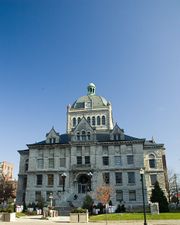
Mayfest is a free outdoor festival that takes place annually over Mother's Day weekend. Held in Gratz park between the Carnegie Center and Transylvania University, the festival typically features up to 100 art and craft booths, live entertainment throughout the weekend, food, children's activities, adult activities and literary events, free carriage rides, a traditional Morris and Maypole dance and various demonstrations.
Taking part the first full weekend of June is the Festival of the Bluegrass, Kentucky's oldest bluegrass music festival. It includes three stages for music and a "music camp" that teaches the bluegrass music to school children. Also in June is the popular Broadway review presented by UK Opera Theatre, "It's A Grand Night for Singing!"
Later in June, the Gay and Lesbian Service organization hosts the Lexington Pride Festival, currently into the planning phases of its third festival as of 2009, the event is popular among the diverse communities in Lexington.
Lexingtonians gather downtown for the Fourth of July festivities which extend for several days. On July 3, the Gratz Park Historic District is transformed into an outdoor music hall when the Patriotic Music Concert is held on the steps of Morrison Hall at Transylvania University. The Lexington Singers and the Lexington Philharmonic Orchestra perform at this event. On the Fourth, annual festivities include a reading of the Declaration of Independence on the steps of the Old Courthouse, a waiter's race in Phoenix Park, a parade, a country music concert, and fireworks. Also, throughout the day street vendors sell their wares and food to the downtown visitors. The Fourth of July is considered to be the biggest holiday in Lexington.
"Southern Lights: Spectacular Sights on Holiday Nights",[35] taking place from November 18 to December 31, is held at the Kentucky Horse Park. It includes a three-mile (5 km) drive through the park, showcasing numerous displays, many in character with the horse industry and history of Lexington. The "Mini-Train Express", an indoor petting exotic animal petting zoo, the International Museum of the Horse, an exhibit showcasing the Bluegrass Railway Club's model train, and Santa Claus are other major highlights.
The Lexington Christmas Parade: Held usually the first Saturday in December, the parade route follows Main Street between Midland and Broadway. Festivities include a pre-parade "Santa's Sleigh" charity race, food, light entertainment, and post-show activities.
Other events and fairs include:
- "It's A Grand Night for Singing:" Presented by UK Opera, 2nd and 3rd weekends in June.
- The Artists Market: A small display of arts and craft booths which is set up concurrently with the Farmer's Market each Saturday from the first weekend in June through the last weekend in August. Located on Vine Street opposite the Farmer's Market.
- Thursday Night Live: An annual summer series of free, public concerts held in Cheapside Park every Thursday evening from 5pm - 7pm in June, July & August.
- A Midsummer Night's Run: A 5K race in early August.
- The Woodland Art Fair: An annual event of the Lexington Art League, is held annually in August at Woodland Park and features many local and national artists working in a variety of media.
- The Roots & Heritage Festival: An event that takes place throughout the month of September and consists of a wide variety of culturally enriching activities including art exhibits, literary readings, film presentations, the Festival Ball and the ever-popular two-day street festival featuring live musical performances from internationally renowned artists.
- The Lexington Philharmonic Orchestra presents several annual concerts.[36]
- The Kentucky Women Writers Conference which has hosted dozens of the nations foremost women writers.
- Festival Latino in September
- Gallery Hop: a seasonal event where the city's art galleries are open to the public on the third Friday of every third month.
- Beaux Arts Ball: A masquerade ball hosted by the University of Kentucky's College of Design (formerly College of Architecture).
- Tournament of Champions: One of three national high school debate championship tournaments featuring policy debate and Lincoln-Douglas debate. The best teams in the nation meet after qualifying during the regular season on the first weekend in May annually.
- Lexington Pride Festival: An annual summer event to celebrate pride in the lesbian, gay, bisexual, and transgender communities. Lexington has one of the highest concentrations of gay and lesbian couples in the United States for a city its size.[37]
Historical structures and museums


Lexington is home to numerous museums and historical structures. One of the most famous is Ashland: The Henry Clay Estate along Richmond Road east of downtown. This two-story museum is a National Historic Landmark and was the former home of statesman Henry Clay.
Lexington Public Library, in the Phoenix Park area near the geographic center of Lexington, houses the world's largest ceiling clock, a five story Foucault pendulum and a frieze depicting the history of the horse in the Bluegrass. The library and its branches also house art galleries and traveling exhibits.
Another important museum is the Lexington History Center in the old Fayette County Courthouse in the heart of downtown. It offers two museums, one dedicated to the history of the region and the other dedicated to public safety. A third museum, devoted to the history of pharmaceuticals in the Bluegrass, is under construction. It will also be home to the Isaac Scott Hathaway Museum in 2007 as well.
- Aviation Museum of Kentucky
- The Headley-Whitney Museum
- Hunt-Morgan House
- Kentucky Theatre
- Lexington Cemetery
- Martin Castle
- Mary Todd Lincoln House
- Old Morrison, on the Transylvania University campus
- Rupp Arena
- Waveland State Historic Site
The UK Art Museum is the premier art museum for Lexington and the only accredited museum in the region. Its collection of over 4000 objects ranges from Old Masters to Contemporary, and it also hosts ongoing special exhibitions.[38]
The local Woolworth's building was listed on the National Register of Historic Places for its significance as a site of civil rights protests against segregation during the 1960s. Nonetheless, the building was demolished in 2004 and the area paved as a parking lot.[39]
Media
Lexington's largest daily circulating newspaper is the Lexington Herald-Leader. The region is also served by eight primary television stations, including WLEX, WKYT, WDKY, WTVQ, The CW, WKLE, and MyNetworkTV. The state's public television network, Kentucky Educational Television (KET), is headquartered in Lexington and is one of the nation's largest public networks.
Parks and outdoor attractions
City parks and facilities
Lexington has over 100 parks ranging in size from the 8,719-square-foot (810.0 m2) Smith Street Park to the 659-acre (2.7 km2) Masterson Station Park.[40][41] There are also six public golf courses at Avon, Kearney Links, Lakeside, Meadowbrook, Tates Creek and Picadome and four dog parks, at Jacobson, Masterson Station, Coldstream, and Wellington. It also has two public 18-hole disc golf courses at Shillito Park and at Veterans Park, and a public skate park at Woodland Park, featuring 12,000 square feet (1,100 m2) of "ramps, platforms, bowls, and pipes".[40]
Lexington Cemetery is on the National Register of Historic Places, not only because of notable people interred there, but because it was founded during the major cholera epidemic of 1848.
Horse racing tracks
Lexington is home to two historic horse racing tracks. Keeneland, sporting live races in April and October since 1936, is steeped in tradition where much has not changed since the track's opening. The Red Mile Harness Track is the oldest horse racing track in the city, and second oldest in the nation. This is where horses pull two-wheeled carts called sulkies while racing, also referred to as harness racing. The Kentucky Horse Park, located along scenic Iron Works Pike, is a relatively late-comer to Lexington, opening in 1978. It is a working horse farm and an educational theme park, along with holding the distinction of being a retirement home for some of the world's greatest competition horses including Cigar and 2003 Kentucky Derby winner Funny Cide. It will play host to the 2010 FEI World Equestrian Games.
Natural areas
The city is home to Raven Run Nature Sanctuary, a 734-acre (3.0 km2) nature preserve along the Kentucky River Palisades.[40][42] There are 11 miles (18 km) of back-country hiking trails that range from wheelchair-accessible paved trails to difficult single-track trails. It is common to run across hopeful Appalachian Trail backpackers. The city has recently purchased land adjacent to the park which will make Raven Run the largest park in the city. Raven Run is home to over 56 species of trees, 600 species of plants, 200 species of birds, and other wildlife. Remains of a grist mill, homestead and limekiln remain. The preserve also has a nature center and various educational programs throughout the year. Such programs include seasonal wildflower walks, stargazing during the warmer months, evening insect tours, and historical walks and presentations.
The Arboretum is a 100-acre (0.40 km2) preserve adjacent to the University of Kentucky.[40] It features the Arboretum Woods, a small, 16-acre (65,000 m2) Bluegrass Woodland patch that is home to eighteen native Kentucky tree species, and more than 50 native Kentucky grasses and herbs. It also has 1,500 varieties of roses in the Rose Garden, a Home Demonstration Garden, and numerous paved paths and trails.
The city also plays host to the historic McConnell Springs, a 26-acre (110,000 m2) park within the industrial confines off of Old Frankfort Pike.[40][42] There are two miles (3 km) of trails that surround the namesake springs, historic dry-laid stone fences, and historical structures.
Sports
College athletics

The Kentucky Wildcats, the athletic program of the University of Kentucky, is by far Lexington's most popular sports entity. The school fields 22 varsity sports teams, most of which compete in the Southeastern Conference. The most famous team by far is the men's basketball team, which has won 7 NCAA championships and is the winningest program in college basketball history. Lexington's only other collegiate team, the Transylvania University Pioneers, competes in NCAA Division III athletics.
Lexington produced a number a major collegiate and professional athletes. The more well known include former Tates Creek High School and Louisville Cardinals kicker David Akers, who is the all-time scoring leader for the Philadelphia Eagles; former Louisville Cardinals football player and Cleveland Browns cornerback Frank Minnifield; New York Yankees outfielder Austin Kearns; former Kentucky and Pittsburgh Steelers center Dermontti Dawson; and NBC announcer Tom Hammond.
Professional sports
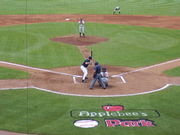
Lexington is home to the Lexington Legends, a Class A minor league affiliate of the Houston Astros. Since its inception in 2001, Lexington has produced numerous major leaguers including: 2009 National League All-Star Hunter Pence (Outfielder) of the Houston Astros, John Buck (Catcher) of the Kansas City Royals, Kirk Saarloos (Pitcher) of the Cleveland Indians, and Mike Gallo (Relief Pitcher), of the Colorado Rockies. The Legends belong to the SAL (South Atlantic League), have one league title (2001) and four playoff appearances since 2001. Roger Clemens pitched in one game for the Legends in 2006 as part of his preparation to return to the Houston Astros.
Lexington was at one time home to the Lexington Horsemen, an arena football team in the arenafootball2 league.
Lexington was at one time home to the Kentucky Thoroughblades, a minor league (AHL) hockey team that played between 1996 and 2001. For one season (2002–2003) the ECHL Men O' War played minor league hockey in Lexington.
The University of Kentucky Hockey team which competes at club level in the American Collegiate Hockey Association
For a time the city was home to the Lexington Bluegrass Bandits who competed in the USL Premier Development League
In fall 2009, Lexington's first professional basketball team, the American Basketball Association's Bluegrass Stallions, will tip off at a brand-new arena currently under construction at the Kentucky Horse Park.
Horse Racing and Equestrian Events

Lexington has been known as a major center for Thoroughbred breeding since the late 18th century due to the high calcium content in the soils of the Inner Bluegrass Region, which leads to stronger bones and greater durability in horses. The city is home to two horse racing tracks, Keeneland and the The Red Mile harness track.
The Kentucky Horse Park in Northern Fayette County hosts the Rolex Kentucky Three Day Event, one of the top 3 annual equestrian eventing competitions in the world. The city will be hosting the 2010 World Equestrian Games, the world's largest equestrian event.
Transportation
Highways
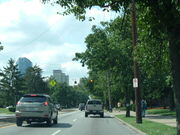
Lexington is serviced by both Interstate 64 and Interstate 75, though neither they nor any other freeway run through the city proper. New Circle Road (KY 4) acts as an inner-beltway around the city, Man o' War Boulevard is a semi outer-beltway south of New Circle Road, and numerous U.S. routes and arterial highways radiate out from downtown to provide access to the numerous bedroom communities ringing the metropolitan area. Citation Boulevard is planned to provide some relief to northern New Circle between Leestown Road and Russell Cave Road. Lexington suffers considerable traffic congestion for a city of its size due to the lack of out- or inbound freeways, the proximity of the University of Kentucky to downtown, and the substantial number of commuters from outlying towns.
Air
Lexington is accessible by air with approximately 65 direct and nonstop flights daily from the two runways of Blue Grass Airport. Seven major airlines operate connection service at Blue Grass, including Airtran Airways, Allegiant Air, American Eagle Airlines, Continental Express, Delta Air Lines, United Express, and US Airways Express.
The airport is located four miles (six km) west of the city center, at the intersection of US 60 (Versailles Road) and Man o' War Boulevard..
Public transportation
Lexington is served by LexTran, a public transit bus agency operated by LFUCG and has been in existence since 1972.
Transportation planning
The Lexington Area Metropolitan Planning Organization is responsible for transportation planning for Fayette and Jessamine Counties. This includes activities such as carpool matching, administering a commuter vanpool program, air quality forecasting, bicycle and pedestrian planning, congestion management, and developing transportation plans and documents.
Sister cities
Lexington has four sister cities, as designated by Sister Cities International:
 Deauville, France since 1957
Deauville, France since 1957 County Kildare, Ireland since 1984
County Kildare, Ireland since 1984 Shinhidaka, Japan since 2006
Shinhidaka, Japan since 2006
- Shinhidaka was formed by a 2006 local government merger. One of the entities involved in the merger was Shizunai, which established a sister city relationship with Lexington in 1988.
 Newmarket, United Kingdom since 2003
Newmarket, United Kingdom since 2003
All four are, like Lexington, major centers of the Thoroughbred breeding industry in their respective countries.
See also
- Lexington in the American Civil War
- Notable residents of Lexington, Kentucky
References
- ↑ 1.0 1.1 "Annual Estimates of the Population for Incorporated Places in Kentucky". U.S. Census Bureau. http://www.census.gov/popest/cities/tables/SUB-EST2006-04-21.csv. Retrieved 2007-06-28.
- ↑ 2.0 2.1 "Annual Estimates of the Population of Metropolitan and Micropolitan Statistical Areas: April 1, 2000 to July 1, 2006 (CBSA-EST2006-01)" (CSV). 2006 Population Estimates. United States Census Bureau, Population Division. 2007-04-05. http://www.census.gov/population/www/estimates/metro_general/2006/CBSA-EST2006-01.csv. Retrieved 2007-04-07.
- ↑ 3.0 3.1 "Annual Estimates of the Population of Combined Statistical Areas: April 1, 2000 to July 1, 2006 (CBSA-EST2006-02)" (CSV). 2006 Population Estimates. United States Census Bureau, Population Division. 2007-04-05. http://www.census.gov/population/www/estimates/metro_general/2006/CBSA-EST2006-02.csv. Retrieved 2007-04-07.
- ↑ url=http://encarta.msn.com/encnet/departments/elearning/?article=educatedcities. Archived 2009-10-31.
- ↑ World Equestrian Games Aachen 2006
- ↑ "First African Baptist Church", Lexington: The Athens of the West, National Park Service, accessed 21 Aug 2010
- ↑ [http://books.google.com/books?id=q6U-AAAAYAAJ&printsec=frontcover&dq=George+Washington+Ranck,+%27%27The+Traveling+Church&source=bl&ots=MRBBN_3FFM&sig=qNIm003ExI9bMSAyFDGaFdm65rY&hl=en&ei=zwhxTL6WJ5KjnQeG5ai9CA&sa=X&oi=book_result&ct=result&resnum=3&ved=0CCEQ6AEwAg#v=onepage&q&f=false George Washington Ranck, The Traveling Church: An Account of the Baptist Exodus from Virginia to Kentucky in 1781 under the Leadership of Rev. Lewis Craig and Capt. William Ellis, Louisville, KY: 1910, p. 22, accessed 21 Aug 2010
- ↑ [http://www.nps.gov/history/nr/travel/lexington/fab.htm "First African Baptist Church"], Lexington: The Athens of the West, National Park Service, accessed 21 Aug 2010
- ↑ [http://www.nps.gov/history/nr/travel/lexington/cce.htm "Christ Church Episcopal"], Lexington, National Park Service, accessed 21 Aug 2010
- ↑ [http://www.drugabuse.gov/NIDA_Notes/NNVol10N6/ARCHistory.html History of the Addiction Research Center]
- ↑ [http://quickfacts.census.gov/qfd/states/21/21067.html Fayette County QuickFacts from the US Census Bureau]
- ↑ [http://maps.howstuffworks.com/united-states-climate-map.htm How Stuff Works] map of American climate zones. Retrieved on 31 Jan 2010
- ↑ [http://www.aafa.org/ Asthma and Allergy Foundation of America - Information About Asthma, Allergies, Food Allergies and More!]
- ↑ CentrePointe at [http://www.cptlex.com/pdf/CPT-2008-1231-PresentationPackage.pdf] collected 05 Feb 2009
- ↑ [http://www.forbes.com/2007/04/16/worlds-cleanest-cities-biz-logistics-cx_rm_0416cleanest_slide_15.html?thisSpeed=undefined Forbes.com] In Pictures: The World's Cleanest Cities. Retrieved 6 Apr 2010.
- ↑ 16.0 16.1 16.2 Lexington-Fayette Urban County, Kentucky (2003-04-17). [ftp://ftp.lfucg.com/Planning/LongRange/greenbrier_plan.pdf "Greenbrier Small Area Plan"] (PDF). Press release. ftp://ftp.lfucg.com/Planning/LongRange/greenbrier_plan.pdf. Retrieved 2007-05-20.
- ↑ 17.0 17.1 17.2 17.3 17.4 Lexington-Fayette Urban County, Kentucky. [http://www.lfucg.com/planning/History.asp "Planning History"]. Press release. http://www.lfucg.com/planning/History.asp. Retrieved 2007-05-20.
- ↑ "Isaac concedes to Newberry for Lexington Mayor." Herald-Leader [Lexington]. 7 November 2006 [http://www.kentucky.com/mld/kentucky/news/politics/elections/15953171.htm].
- ↑ [http://www.aaiusa.org/press-room/994/pr110702 The Arab American Institute web site].
- ↑ [http://factfinder.census.gov "American FactFinder"]. United States Census Bureau. http://factfinder.census.gov. Retrieved 2008-01-31.
- ↑ Hillery Jr., George A. (1966). "Population Growth in Kentucky, 1820-1960". University of Kentucky Agriculture Experiment Station.
- ↑ "1970 Census of the Population, Volume 1: Characteristics of the Population, Part 19, Kentucky". United States Government Printing Office. 1973.
- ↑ "1980 Census of the Population, Volume 1: Characteristics of the Population, Part 19, Kentucky". United States Government Printing Office. 1982.
- ↑ ""KSDC News"". Kentucky State Data Center. Spring 1997.
- ↑ [http://factfinder.census.gov/servlet/SAFFPopulation?_event=Search&geo_id=04000US21&_geoContext=01000US%7C04000US21&_street=&_county=lexington&_cityTown=lexington&_state=04000US21&_zip=&_lang=en&_sse=on&ActiveGeoDiv=geoSelect&_useEV=&pctxt=fph&pgsl=040&_submenuId=population_0&ds_name=null&_ci_nbr=null&qr_name=null®=null%3Anull&_keyword=&_industry= ""Lexington-Fayette, Kentucky - Population finder""]. United States Census Bureau. http://factfinder.census.gov/servlet/SAFFPopulation?_event=Search&geo_id=04000US21&_geoContext=01000US%7C04000US21&_street=&_county=lexington&_cityTown=lexington&_state=04000US21&_zip=&_lang=en&_sse=on&ActiveGeoDiv=geoSelect&_useEV=&pctxt=fph&pgsl=040&_submenuId=population_0&ds_name=null&_ci_nbr=null&qr_name=null®=null%3Anull&_keyword=&_industry=.
- ↑ url=http://www.delta-sky.com/ginc/portrait/lexington/pdf/03_business.pdf
- ↑ url=http://workforce.ky.gov/June08charts.pdf
- ↑ url=http://www.kylandsales.com/blog/lexington-ky-forbes/
- ↑ url=http://www.kiplinger.com/tools/slideshows/Bestcitiessingle/6.htm
- ↑ 30.0 30.1 30.2 [http://www.lexchamber.com/doc_lib/major_area_employers.pdf "Major Employers"] (PDF). Commerce Lexington. 31 August 2006. http://www.lexchamber.com/doc_lib/major_area_employers.pdf.
- ↑ [http://www.jif.com/aboutjif/aj_tidbits.asp "Fun Tidbits"]. J.M. Smucker Company. http://www.jif.com/aboutjif/aj_tidbits.asp. Retrieved 2007-12-28.
- ↑ [http://www.uky.edu/Home/AboutUK/facts.html "University of Kentucky Facts At A Glance"]. University of Kentucky. 31 August 2006. http://www.uky.edu/Home/AboutUK/facts.html.
- ↑ Christie, Les (31 August 2006). [http://money.cnn.com/2006/08/29/real_estate/brainiest_cities "America's smartest cities"]. CNN. http://money.cnn.com/2006/08/29/real_estate/brainiest_cities. Retrieved 2006-09-02.
- ↑ [http://www.wkyt.com/home/headlines/12881277.html "Lexington Ranks As 17th Most Literate City"]. WKYT-TV. 12 December 2007. http://www.wkyt.com/home/headlines/12881277.html. Retrieved 2007-12-28.
- ↑ http://www.kyhorsepark.com/khp/holiday
- ↑ [http://www.lexphil.org/index.php?b=ct_lexphil_on_tour lexphil.org | The Lexington Philharmonic Online | Lexington, Kentucky, USA]
- ↑ Black, B. et al.: "Why do gay men life in San Francisco?", Journal of Urban Economics, 51:54. Retrieved from http://www.ncfr.org/pdf/sections/FF_Gay_men_San-Francisco_Gates.pdf
- ↑ [http://www.uky.edu/ArtMuseum/ University of Kentucky Art Museum]
- ↑ [http://findarticles.com/p/articles/mi_kmpre/is_200408/ai_n6889984 Downtown Lexington's Next Loss: Woolworth's]. Preservation Magazine. August 2004. http://findarticles.com/p/articles/mi_kmpre/is_200408/ai_n6889984. Retrieved 2009-03-07.
- ↑ 40.0 40.1 40.2 40.3 40.4 Fun Guide 2007. City of Lexington, Kentucky, Division of Parks and Recreation. 2007.
- ↑ [http://www.lfucg.com/parks/index.asp PARKS - Lexington-Fayette Urban County Government]
- ↑ 42.0 42.1 Parks. Lexington-Fayette Urban County Government. 31 August 2006 [http://www.lfucg.com/gensvcs/parks/facilities/facilities_locations.asp].
External links
- Official website of Lexington, Kentucky
- Official website of Downtown Lexington Corporation
- Lexington Kentucky: The Athens of the West, a National Park Service Discover Our Shared Heritage Travel Itinerary
- Downloadable PDF and Plain text versions of George Washington Ranck's 1872 book, History of Lexington, Kentucky
|
||||||||||||||||||||||||||||
|
||||||||||||||||||||
|
|||||
